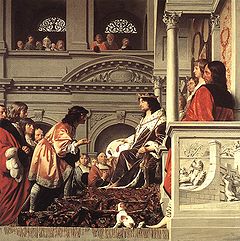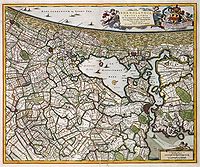
Gemeenlandshuis Zwanenburg
Encyclopedia
.
The Gemeenlandshuis Zwanenburg on the Haarlemmerstraatweg in Halfweg is a former Gemeenlandshuis
of the Hoogheemraadschap van Rijnland
designed by Pieter Post
and built 1645-1648. Today it is part of Sugar City.

 The Hoogheemraadschap van Rijnland
The Hoogheemraadschap van Rijnland
built this building as a meeting hall to use for water management
of the Ij
and the Haarlem Lake in 1645. They had previously built a similar meeting house in 1641 to oversee the dam in Spaarndam
. Since 1518 when the Hoogheemraadschap sent men to defend the dam at Spaarndam from troops sent by the rebellious city of Haarlem
, the Hoogheemraadschap had met for water management on neutral ground in Leiden. To be able to meet more efficiently during yearly inspection of the dikes, they built meeting halls in strategic locations outside the Haarlem city limits on their own terrain. The Hoogheemraadschap privileges were considered a higher form of government than the Haarlem city rights (awarded to Haarlem in 1245), and were described in a document that was given to the dike wardens at Spaarndam in 1255. This granting of privileges by Count William II of Holland was the subject of a painting by Caesar van Everdingen
that was painted as decoration for the meeting hall in Halfweg, and which hangs today in the Gemeenlandshuis van Rijnland
, the meeting hall purchased in 1578 on the Breestraat in Leiden.
This building was also the permanent residence of the Halfweg dijkgraaf (official). The duties of the dike warden changed over time and Zwanenburg evolved into a weather station. The Zwanenburg resident Jan Noppen (1706–1734) and his friend and Spaarndam water board colleague Nicolaas Kruik
were inspired by the British Royal Society to measure the temperature, air pressure, humidity, and rainfall 3 times daily. They decided to measure wind as well and it was Jan Noppen who invented the Dutch windspeed standard based on the amount of sail in use on windmill sail
s. For example, when it was too dangerous to run the mill, it was considered "molenwind 13", which today is "windkracht 8" or gale force on the Beaufort scale
.
The location was later in use by the town hall and chamber of commerce of Halfweg, and eventually in 1919 the newly formed N.V. Centrale Suiker Maatschappij, or CSM Suiker fabriek, set up headquarters there.
The Gemeenlandshuis Zwanenburg on the Haarlemmerstraatweg in Halfweg is a former Gemeenlandshuis
Gemeenlandshuis
A Gemeenlandshuis, or Waterschapshuis is a building that is or was formerly used as the headquarters of one of the Waterboards of the Netherlands. The Netherlands has 27 Waterboards or Waterschappen.-History:...
of the Hoogheemraadschap van Rijnland
Hoogheemraadschap van Rijnland
The Hoogheemraadschap van Rijnland is the oldest Water board of the Netherlands, having received its first commission to protect the land from flooding back in 1248 from William II of Holland. It conducts water control activities in the general area known as Rijnland...
designed by Pieter Post
Pieter Post
Pieter Jansz Post was a Dutch Golden Age architect, painter and printmaker.-Biography:...
and built 1645-1648. Today it is part of Sugar City.
History


Hoogheemraadschap van Rijnland
The Hoogheemraadschap van Rijnland is the oldest Water board of the Netherlands, having received its first commission to protect the land from flooding back in 1248 from William II of Holland. It conducts water control activities in the general area known as Rijnland...
built this building as a meeting hall to use for water management
Water management
Water management is the activity of planning, developing, distributing and managing the optimum use of water resources. In an ideal world. water management planning has regard to all the competing demands for water and seeks to allocate water on an equitable basis to satisfy all uses and demands...
of the Ij
IJ (bay)
The IJ is a river, formerly a bay, in the Dutch province of North Holland. It is known for being Amsterdam's waterfront. The name derives from the generic Germanic term for "water" and is similar to other Aa/Ee names for bodies of water. In Dutch, the name consists of the digraph ij, which is...
and the Haarlem Lake in 1645. They had previously built a similar meeting house in 1641 to oversee the dam in Spaarndam
Spaarndam
Spaarndam is a small village in the province of North Holland, the Netherlands, on the Spaarne and IJ rivers. The oldest part of the village, on the western side of the Spaarne, belongs to the municipality of Haarlem; the newer part on the eastern side is a part of the municipality of...
. Since 1518 when the Hoogheemraadschap sent men to defend the dam at Spaarndam from troops sent by the rebellious city of Haarlem
Haarlem
Haarlem is a municipality and a city in the Netherlands. It is the capital of the province of North Holland, the northern half of Holland, which at one time was the most powerful of the seven provinces of the Dutch Republic...
, the Hoogheemraadschap had met for water management on neutral ground in Leiden. To be able to meet more efficiently during yearly inspection of the dikes, they built meeting halls in strategic locations outside the Haarlem city limits on their own terrain. The Hoogheemraadschap privileges were considered a higher form of government than the Haarlem city rights (awarded to Haarlem in 1245), and were described in a document that was given to the dike wardens at Spaarndam in 1255. This granting of privileges by Count William II of Holland was the subject of a painting by Caesar van Everdingen
Caesar van Everdingen
Cesar Pietersz, or Cesar Boetius van Everdingen , older brother of Allart van Everdingen and Jan van Everdingen, was a Dutch Golden Age portrait and history painter.-Biography:...
that was painted as decoration for the meeting hall in Halfweg, and which hangs today in the Gemeenlandshuis van Rijnland
Gemeenlandshuis van Rijnland
.The Gemeenlandshuis van Rijnland on the Breestraat in Leiden is the oldest Gemeenlandshuis of the Netherlands that kept its function until the current century. Currently, it is still in use by the Hoogheemraadschap van Rijnland, but only for meetings and special occasions...
, the meeting hall purchased in 1578 on the Breestraat in Leiden.
This building was also the permanent residence of the Halfweg dijkgraaf (official). The duties of the dike warden changed over time and Zwanenburg evolved into a weather station. The Zwanenburg resident Jan Noppen (1706–1734) and his friend and Spaarndam water board colleague Nicolaas Kruik
Nicolaas Kruik
Nicolaas Kruik , also known as Nicolaes Krukius or most commonly by the Latinized Nicolaus Samuelis Cruquius, was a Dutch land surveyor, cartographer, astronomer and weatherman...
were inspired by the British Royal Society to measure the temperature, air pressure, humidity, and rainfall 3 times daily. They decided to measure wind as well and it was Jan Noppen who invented the Dutch windspeed standard based on the amount of sail in use on windmill sail
Windmill sail
Windmills are powered by their sails. Sails are found in different designs, from primitive common sails to the advanced patent sails.-Jib sails:...
s. For example, when it was too dangerous to run the mill, it was considered "molenwind 13", which today is "windkracht 8" or gale force on the Beaufort scale
Beaufort scale
The Beaufort Scale is an empirical measure that relates wind speed to observed conditions at sea or on land. Its full name is the Beaufort Wind Force Scale.-History:...
.
The location was later in use by the town hall and chamber of commerce of Halfweg, and eventually in 1919 the newly formed N.V. Centrale Suiker Maatschappij, or CSM Suiker fabriek, set up headquarters there.

